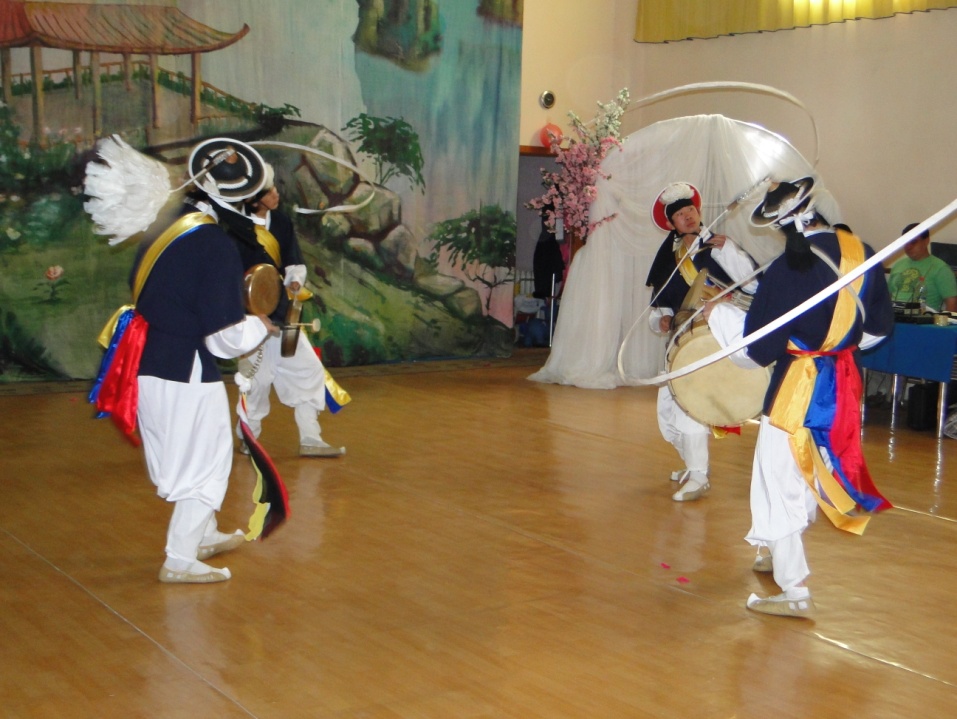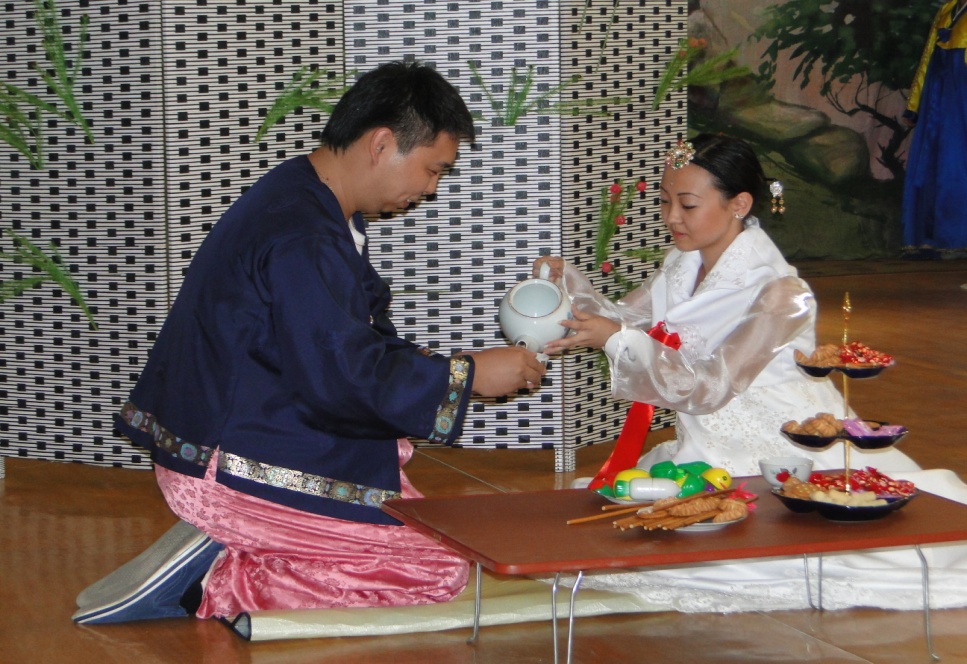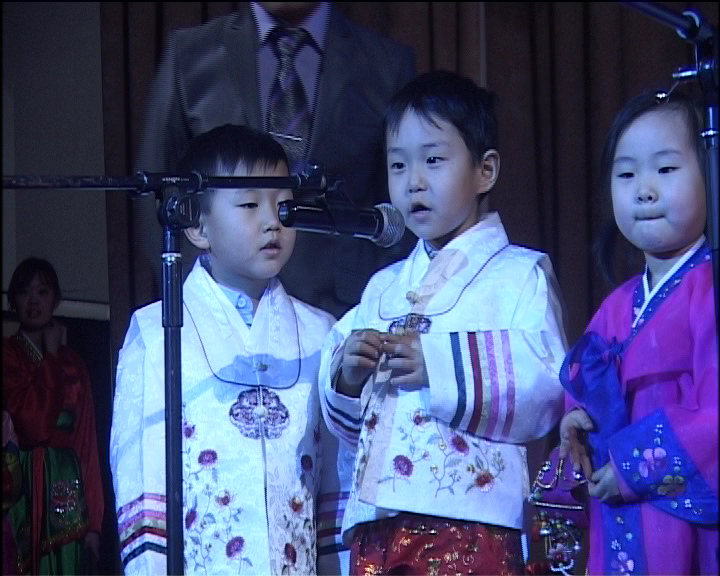The Koreans of Kazakhstan: Music Art at the Present Stage
Over 130 ethnical groups inhabit the young sovereign state of Kazakhstan. Cherishing their traditions and customs, they make a laudable contribution to our country’s progress.“The history of the Assembly is that of the country and that of the nation.”
Nursultan Nazarbayev

Over 130 ethnical groups inhabit the young sovereign state of Kazakhstan. Cherishing their traditions and customs, they make a laudable contribution to our country’s progress. The republic’s citizens practice a special relationship model based on the principle of respect for human rights and freedoms as well as that of interethnic concord enhancement and cooperation. In this respect, a vast historical, cultural, and social research into the abundant and diverse music art of the ethnic groups inhabiting Kazakhstan is one of today’s most topical humanitarian issues. In this regard, Kazakhstan is a unique country presenting a most fruitful symbiosis of various cultures. Nowadays, expatriate communities are the focus of many branches of science, such as history, political science, ethnology, social, economic, and cultural studies, etc. “Having no knowledge of the key stages in diaspora formation, disregarding the historical context as well as the way in which expatriate communities are related to the history of their ancestral land as well as the country currently hosting them, we cannot but provide an analysis lacking in depth and ill-grounded prospective estimates [1].” It was the project program for the Assembly of the People of Kazakhstan introduced by the Republic’s First President N. A. Nazarbayev what enabled researchers to study the authentic expatriate musical cultures developing in various geographic areas to reflect the special relationships and the ethnic-specific routine, the continuity of traditions, and spiritual focuses, as well as to identify the mutual influence and interrelation of music and local culture.

The fact that on April 25, 2013 the 20th Session of the Assembly of the People of Kazakhstan took place in Astana is clearly evidence to its activity being extremely fruitful. The President’s speech for the Day of Unity of the People of Kazakhstan contained the following words, «Over the years, the Assembly has come of full age and turned into a major general civil institute of our nation. Kazakhstan has become a territory which is free of ethnical conflict. Economic, social, and political reforms have been introduced successfully due to the interethnic peace and harmony. Every house can enjoy peace and quiet now. This is the key outcome of our work and that of the Assembly. Nowadays we are fully entitled to claim the Assembly to be the entire nation of Kazakhstan. The seventeen million people. At present, the Assembly is a reliable and durable basis for stability and public concord. Now that the circumstances are changed, the Assembly should become a truly supra political, nation-wide civil institution. It is recognized by the UNO, the OSCE, and the CICMA[1]. The Assembly is an institution to represent the entire nation. No ethnic group has lost its language in Kazakhstan over the years of independence. We cherish the cultures of our smallest ethnic communities, such as Assyrians, Laks, Ritutuls, and many others, and foster their progress in every possible way. Tolerance is a moral standard of our society, which we are going to enhance, preserve, and encourage in all generations” [2]. The Assembly of the People of Kazakhstan, which is headed by the Republic’s First President, and reasonable state policy made a most important structure-forming core, which serves as the basis for political correctness, tolerance, unity, friendship, mutual consent, and respect for every nationality that lives in our country. “Nowadays, our state performs the truly unique function of providing equality and full-blooded development for every ethnic group, while the latter determine the new quality of Kazakhstani culture. The unity of national cultures is the basis of a nascent cultural phenomenon. Kazakhstan has become a country whose positive interethnic experience has been globally recognized, serving as a 21st century gold standard for national policy.” [3, p.3]

Studying expatriate culture includes raising and solving the most topical and pressing issues of contemporary Kazakhstani art, both national and belonging to smaller ethnic groups, the cultural dialogue between the parent state and the diasporas, that of heritage and innovation as well as the interaction of western and eastern artistic cultures. Most notably, the processes foster the formation of profound cognition of the genesis of polyethnicity, that is, the ethnic pluralism of the Kazakh land. Surveys to explore the origin and development of the expatriate communities inhabiting the republic is doubtless scientific, social, and political interest.

The present article is one of the first attempts at studying the formation and functioning of the music culture of the Kazakhstani Korean diaspora. In this article, we have presented the area-specific creative process and studied the key factors determining the artistic activity of certain outstanding representatives of the ethnic group.
The important function of the Association of Kazakhstani Koreans (AKK) in coordinating the work of Korean culture centers should be mentioned. Its top priorities are such essential aspects as providing a resurgence of the Korean language as well as ethnic-specific customs and traditions, exploring the ethnical roots, fostering the development of the authentic Korean culture, art, and literature, providing protection of rights and interest representation for Kazakhstani Koreans, enhancing interethnic friendship, and developing international cultural and economic relations.
At the same time, numerous amateur artistic groups have been created; republic-wide cultural and artistic festivals as well as Korean science and art exhibitions take place. The Association initiated the publishing of the encyclopedia titled “The Soviet Koreans of Kazakhstan” and “Kazakhstani Koreans in Science, Engineering, and Culture” along with a historical essay titled “The Koreans of Kazakhstan”[2]. A book titled “The Koreans of Kazakhstan: An Illustrated History” in three languages, namely Russian, Korean, and English, was published to celebrate the 60th anniversary of the Korean community of Kazakhstan, and a brightly illustrated popular book titled “Korean Customs and Traditions” compiled by Choi Aen Keun, Yan Won was published to mark the 70th anniversary.
The Korean community of Kazakhstan is very active in many spheres. Numerous public activists, scientists, artists, and people of other trades and occupations belong to it. Its music theater, which is with good reason considered to have originated with the Sinhanchon (New Korean Village) Club.
Historically, the National Republican Korean Theatre of Musical Comedy has been central to the culture of the Kazakhstani Korean community. It is a unique artistic body currently offering jobs to a fourth generation of national artists and theater workers. In September, 2012 the Korean Theater of the Republic of Kazakhstan turned 80. The Theater has staged about 500 plays, scenes, and concert programs. It has preserved the beautiful traditions, their continuity, and the community’s enormous potential for creation. The Koreans are proud to have a national theater of their own. There is no state Korean theater in Japan, in the USA, Malaysia, Singapore, and even in China, where the Korean community is quite big.
Korean actors, musicians, singers, and performers, whose names are listed in numerous prestigious reference books, encyclopedias, and monographic studies, have contributed to the progress of Kazakhstani theater and music art greatly. They include the People’s Artist of the SSR V. E. Kim (actor, film director, and screenplay writer), G. S. Kim, classic guitarist, composer, and author of many songs. He used to be the leading singer of the Zvyozdochka and Synthesis (featuring N. Nurmuhamedova) jazz bands, which were incredibly popular across the USSR, and such Korean bands as Kayagym and Chen-Chun. The “Classic Guitar in Russia and the USSR” encyclopedia mentioned him as a classic guitar player. G. S. Kim is the author of the following works: “A Fantasy on Korean Songs,” “Variations of Motherland Songs,” “Guitar Etudes and Songs”, etc. His songs have been performed by the RK People’s Artists R. Rymbayeva, Laki Kesoglu, and such Korean musicians as Georgiy Son and Mun Gon Dya across Kazakhstan and far beyond its borders.
Vladimir Shin, Artistic Director of the Rodina Choir – 87017217871
Pavel Lim – 2908456
Pedangel (The Silk Way), a choir
Pak San Won – 383068, 87057150002
Yakov Khan - 87017561717 (son Vladimir theater)
Nikolay Kim (KHAKAK) – the Kazakh-Korean Scientific Community 87019329014
Tatyana Choi (theater) - 87017389578
Zoya Kim (singer)
German Kim (Doctor of Historical Sciences) – 87029878610
Stanislav Khegay (mother Ludmila) – 87014146341
Vladimir Kim
Such composers as Pak Yen Din and Ten In Muk have made an enormous contribution to the progress of Korean stage culture. Initially, Yen Sen Nen and Kim Hya Un played a major role in its life. They made up concert programs including Korean folk and contemporary songs, dance, vocal choreography, satire, humor, and compering. Yen Sen Nen can be called a pioneer of the Korean song as is today. His songs “Sow the Seeds Merrily” and “Express Train” were highly popular with the audience.
The Artistic Director of the Ariran Ensemble, the KazSSR Merited Artist Vladimir Kim as well as the Chief Theater Director E. Bogushevskiy worked fruitfully to promote Korean music. The Theater-based ensemble, founded in 1968, was widely recognized popular. It undertook successful tour around Russia, Ukraine, Georgia, Armenia, Azerbaijan, and Moldavia, promoting the unique Korean stage art. The People’s Artist Rimma Kim made a significant contribution to modern Korean dance development [5].
Such talented Korean composers as Ten Chu and Vladimir Srigotskiy-Pak are famous representatives of the Kazakhstani composing school. They have been widely recognized both domestically and globally. Their works do claim the attention of amateurs as well as professionals.
Works by the abovementioned masters is one of the bright and amusing chapters in the history of contemporary Kazakhstani music. A deep patriotic feeling, high professionalism, and a masterful application of modern composing techniques reflect the diverse creativity of Korean composers to tell the story of their ancestral land and its nature, to picture the delicate undertones of tradition Korean music in works of all genres created during various periods. In their melodic pattern showing most distinct rhythmical figures, they paint reality with truly authentic and living colors to demonstrate the rich and unique chatoyant intonation.
The composer, music scholar, and teacher Ten Chu is graduated from the Composing course of Moscow Conservatory, where Professor A. Aleksandrov was his mentor, in 1958, became an associate professor in 1977, and, guided by B. Yerzakovich, presented his thesis in 1978 to obtain a PhD in Music Science. He has been working in many spheres since he moved to Almaty, demonstrating astonishing creative sustainability, intelligence, versatility, a tireless and truly contagious love of work. He is the author of the Pyohgyang Cantata, a symphonic poem titled “The Land of Morning Freshness”, the Dramatic Suite, The Feast of Harvest Suite, the songs “October Flame” and “The Tractor Girl”, and many more. His works are marked by the distinct national color of Korean folk Melos as well as a unique harmony and polyphony presented in the orchestral texture [6].
Ten Chu is the author of a number of scientific publications – “Korean Historical Songs” (1973), “Korean Lyrical Songs by Ariran Band” and “The New Song Genres of Soviet Koreans” (1976), and the composer of a number of plays by the Republican Korean Musical Drama Theater. He has been consistently active as a folk music scholar. He has traveled around Kazakhstan and Central Asian republics to record about 1,000 works of ancient and contemporary Korean folk art.
An active creative pursue in the symphonic genre, which has been a distinct trend of his work over the past four decades, should be mentioned. Deeper ideological and imagery concepts and modern composing techniques combined to create works with a national core which are marked by a philosophic approach to the conceptual solution and are often written in a musical language which is hard to perceive in terms of psychology. Among several authentic symphonic works by Kazakhstani composers, the most broad-scale and widely recognized one is the 5-section dramatic suite for symphony orchestra titled “11.09.1937 17:30 STALIN” by the Korean composer Ten Chu deserves to be mentioned specially. It tells the tragic story of the Korean community during the deportation period. The names of its section are a most accurate reflection of the atmosphere – “The Order and the Stirring”, “Despair”, “Memories of Motherland”, “Grievance”, and “Cry”.
Being a mid-generation composer, V. Strigotskiy-Pak is versatile in his representation of the Korean community. He is the author of works of every genre – music composed for drama plays and television films, stage music, and numerous jazz pieces. His major works, vocal compositions, have been created by Strigotskiy-Pak continuously. The composer is the author of many instrumental plays and chamber ensembles consisting of varying instruments. Despite the diversity of genres in compositions by Strigotskiy-Pak, symphonic music is undoubtedly a special sphere of the composer’s activity, acting as a sort of laboratory in which music of ethnical color is born.
A sophisticated interaction of western and eastern cultures, interpretations of modern composing techniques, and an unparalleled style rooted in the tradition Kazakh and Korean cultures. “Strigotskiy-Pak’s artistic method is largely based on the characteristic features of East Asian and Korean music combined for intonations, phonation techniques, pentatonic sequences of sounds, rhythmical formulas, heterophony as the major texture type, nationality-specific elements of Korean music, and ways to mark the beginning and the end of melodic lines, compositions, etc. They have a simultaneous effect of an intricate pattern interwoven with western styles and techniques selected for matching the above described basis. The composer was able to realize the importance of rendering the ethnic color in his works as soon as he began mastering the western technique, which has never been a goal to pursuit for him.” [7, с.62]
Since the creative endeavor of these leading Kazakhstani composers fully representing the art of the country’s Korean community is thoroughly dynamic, their legacy is continuously growing, and new ideas and woks keep appearing.
Thus, the history of Kazakhstani Koreans with its chapters of mirth and tragedy is a heritage of which the entire community, the entire Kazakhstani nation is proud. The Koreans of Kazakhstan have a tory of their own, in which the history of their ancestral land, Korea, is tightly interwoven with that of Russian Far East, which used to be a destination for massive emigration with their families, and that of Kazakhstan, which not only sheltered Koreans in the hard times of deportation but truly became their motherland. The hospitality and friendly attitude of the people of union republics, who welcomed Koreans during the periods of compulsive and forced migration, is an evidence of highly moral relations between the countries who supported the Koreans and helped them survive repression. It is an evidence of profound historical interrelations between Korean and Kazakhstan and illustrates the historical achievement of every nationality of the multiethnic Kazakhstan. It is no wonder that the Korean theater, the Senbon newspaper, the Korean Pedagogical Institute, the Korean Pedagogical College, and numerous books in Korean, which were the focal points of the Koreans’ intellectual potential, originated in Kazakhstan during that very period. The noble Koreans demonstrated courage and dignity in standing their trials to make selfless contributions to the country’s progress, enhancing social stability and interethnic consolidation for the sake of their motherland, the sovereign Republic of Kazakhstan. Despite of the ordeal, they have been able to preserve and multiply their many generations’ heritage trough time. This is especially true for the music art of the Korean community of Kazakhstan. Both their folk and contemporary music fully reflect the tragic meaning of their historical reality, presenting a beautiful and dignified interpretation of folk tale lyrics. Music scholars have wide prospects in terms of exploring the cultural aspect of this expatriate community, and we do believe new discoveries are to come in the nearest future.
References:
- Dzhashanlo R.E. An Outline on the History of the Dungans. Almaty: Lem Publishing House LLP, 2011. – 308 с.
- An extract from the Day of Union of the People of Kazakhstan Celebration Speech by the President of the Republic N.A. Nazarbayev. April 25, 2013.
- Sheriyazdanova K. The Idea of Peace and Concord./Kazakhstanskaya Pravda 07.03.2010.
- An extract from the 60th Anniversary of the Korean Community in Kazakhstan Celebration Speech by the President of the Republic N.A. Nazarbayev, 10 October, 1997
- Internet. е-mail: info.akk@gmail.com
- Yerkibayeva A.M. Vladimir Strigotskiy-Pak. A Portrait of the Composer. Master of Arts Thesis in Subject 6м041100 – Composition. 2012
- Composers and Music Scholars of Kazakhstan. /The Reference Book of the Kazakhstani Union of Composers. Almaty: Өнер, 1983. 129.
Musagulova G. Zh.
Candidate of Arts,
Associate Professor, Head of Music Studies Department,
M. O. Auezov Institute
For Literature and Arts
[1] Conference on Interaction and Confidence-Building Measures in Asia
[2] Documental films have been shot – the 6-part “My Second Motherland” and “The Koreans of Kazakhstan.” Historical ethnographic expositions on the Korean community of Kazakhstan opened at the Regional Museum for Local Ethnography of Ust-Kamnegorsk and Ushtobe.
 Қысқа да нұсқа. Жазылыңыз telegram - ға
Қысқа да нұсқа. Жазылыңыз telegram - ға